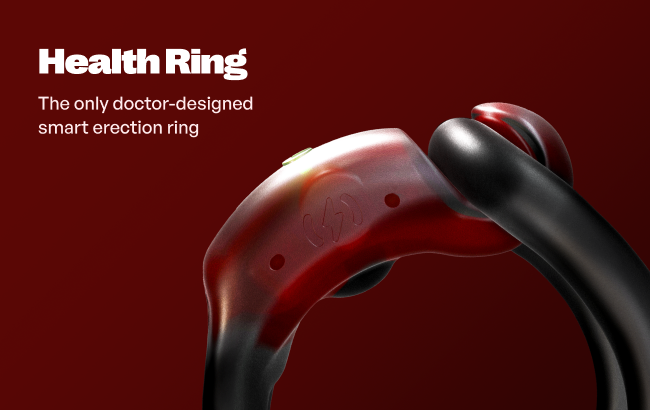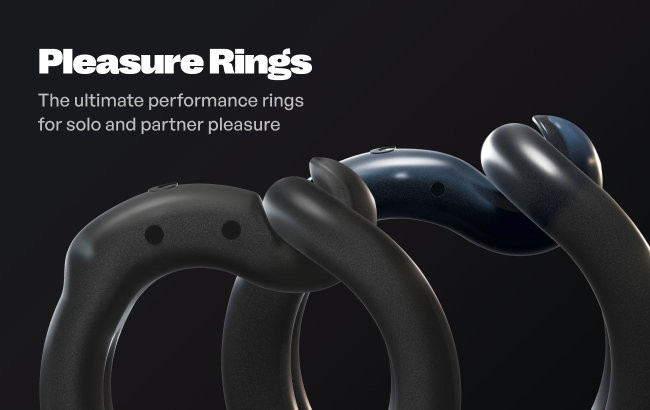If you are curious about erection health, cardiovascular risk, or why “morning erections” happen, you have likely come across the nocturnal penile tumescence test. Also called an NPT test or NPTR test (nocturnal penile tumescence and rigidity), this classic nocturnal erection test measures erections during sleep, when most episodes occur in REM sleep. In this guide, you will learn how the lab test works, how doctors interpret it, and how an at-home approach using a wearable erection sensor can help you track useful trends without a sleep lab.
FirmTech’s TechRing is designed to function as both an erection tracker ring and an erectile health wearable. It tracks erection duration, erection firmness, and the number of nocturnal erections, then summarizes those data in an Erectile Fitness Score that you can review over time. Explore the Science, Health, HSA/FSA, and Shop pages to see how it fits your goals.
Quick Overview
- What the test measures: frequency, duration, and rigidity during sleep. The test has been used to help distinguish psychogenic vs organic ED in selected cases. See the American Urological Association (AUA) guideline for context on when NPT is considered and how results are interpreted (AUA ED Guideline).
- Why it matters: ED and cardiovascular disease share biology involving blood flow, endothelial dysfunction, and nitric oxide signaling. ED can be an early warning sign that deserves a heart health check-in (American Heart Association).
- Home tracking today: A RigiScan alternative experience is possible with a sleep erection monitor like the TechRing that supports a home NPT test style routine. This gives you repeatable, real-world data that you can share with your clinician alongside a validated symptom score such as the IIEF questionnaire (IIEF PDF).
What Is a Nocturnal Penile Tumescence (NPT) or NPTR Test?
In a sleep lab, an NPT test records erections across multiple nights using two small strain gauges. Clinicians then review how many nocturnal erections occurred, how long they lasted, and how rigid they became. This information can support a fuller erectile function assessment when the clinical picture is unclear. The AUA notes that NPT has historically been used to help separate psychogenic from organic causes by looking for preserved sleep-related erections in psychogenic cases (AUA ED Guideline).
Key measurements in an NPTR study:
- Frequency of nocturnal erections
- Duration of each episode and the total time erect
- Rigidity at the base and tip, often summarized as percentages
Older research on the classic RigiScan test suggests that base rigidity may align better with function than tip readings and that rigid-enough cut points have limits in real life (PubMed: Licht 1995). Later reviews discuss strengths and limitations of NPTR for differentiating psychogenic from organic ED (PubMed: Zou 2019).
Why Nocturnal Erections Happen
Most sleep-related erections cluster in REM sleep, which cycles throughout the night. Understanding this pattern explains why single-night results can be misleading and why multi-night data help more than a one-off snapshot. For accessible background on sleep stages and REM timing, see Sleep Foundation’s overview and StatPearls on REM physiology (Sleep Foundation: REM Sleep, NCBI Bookshelf: Physiology, REM Sleep).
ED, Vascular Health, and Heart Risk
ED can reflect vascular issues that also affect the heart and brain. The American Heart Association highlights ED as a potential early warning that should prompt a cardiovascular risk review (AHA news). That link runs through blood flow, endothelial dysfunction, and nitric oxide pathways. This is one reason many men use ongoing erectile function test style tracking to see how sleep, exercise, and overall health relate to erection quality.
For plain-language refreshers on erectile dysfunction and treatment choices, see MedlinePlus and the Urology Care Foundation (MedlinePlus: ED, Urology Care Foundation: ED).
Classic Sleep-Lab NPT vs At-Home Monitoring
Sleep-lab NPTR with polysomnography:
- Multi-night testing with strain gauges
- Detailed staging with professional oversight
- Time-intensive and not always necessary
At-home monitoring with a wearable erection sensor:
- A nocturnal erectile monitoring device you control
- Repeatable nightly data in your own bed
- Objective trends that support a real conversation with your clinician
The TechRing provides a RigiScan alternative experience at home. It functions as an erection monitor ring and erectile performance tracker, summarizing your data into an Erectile Fitness Score you can track week by week. Learn more on the TechRing page, Science, and Health pages.
Helpful context: Research suggests that pairing erection data with sleep context improves interpretation of NPTR trends (Open-access study on sleep quality and NPTR).
Step-By-Step: How To “Test” Nocturnal Erections At Home
- Set a baseline period - Plan for several nights. Sleep varies from night to night, and REM sleep erection test results can fluctuate with stress or schedule.
- Wear the device correctly - Fit your erection tracker ring per the sizing guide on the TechRing product page. Aim for snug and comfortable before sleep.
- Note simple context - Track basics such as sleep time, exercise, alcohol, late meals, or new medications. These lifestyle factors can shape results. For easy education on erection problems and medication effects, see MedlinePlus (Drugs that may cause erection problems).
- Review the right metrics
- Nocturnal erection frequency test style count
- Erection duration across the night
- Erection firmness as a practical stand-in for rigidity
- Your Erectile Fitness Score trend
5. Pair with a validated symptom score - Print and complete the IIEF questionnaire and bring it to your visit (IIEF PDF). This strengthens your erectile function assessment.
Interpreting Trends Without Guesswork
There is no single “perfect” number for every man. Look for patterns over weeks, not hours.
- Consistency over time - Is your erectile quality monitor trend stable, improving, or declining month to month?
- Day versus night - Preserved nocturnal erections with daytime problems often suggest a psychogenic component such as performance anxiety. Flattened nocturnal trends may point toward organic factors that deserve medical review. The AUA describes how NPT fits into selected workups and where it has limits (AUA ED Guideline).
- Sleep factor - Better sleep supports better results. Most REM occurs in the second half of the night, so extremely short sleep can distort data (StatPearls: REM Sleep).
Common Questions
How does a lab NPT test compare with home tracking?
A lab NPTR test uses strain gauges in a supervised setting and can be paired with full polysomnography. At home, a wearable erection sensor offers repeatable data about the outcomes people care about most such as nocturnal penile tumescence, erection duration, and firmness. Both approaches can complement each other. If you need step-by-step clinical evaluation, see the patient resources at MedlinePlus and the Urology Care Foundation (MedlinePlus: Erection problems, Urology Care Foundation: ED).
What about the stamp test vs NPT?
The stamp test only shows movement around the penis during sleep. It does not quantify penile rigidity or duration. An NPT test or erection monitor ring provides richer trends that align with how clinicians think about treatment.
Can at-home data help tell psychogenic vs organic ED?
It can provide clues. Preserved nocturnal data alongside situational daytime problems often suggests a psychogenic component. Consistently poor nocturnal data may point to vascular or endocrine factors. Interpretation still belongs with your clinician. For a research overview, see the 2019 review on NPTR’s role in psychogenic ED (PubMed: Zou 2019) and guidance context from the AUA (AUA ED Guideline).
What if medications, alcohol, or stress are in the mix?
Many medicines and recreational drugs can influence erection quality. Never change prescriptions without speaking with your clinician. For a neutral overview, see MedlinePlus on drugs that may cause erection problems (MedlinePlus).
Are PDE5 inhibitors part of the plan?
They often are. PDE5 inhibitors can improve blood flow during sexual activity when prescribed appropriately. Read a plain-language overview at the Urology Care Foundation and MedlinePlus (Urology Care Foundation: ED, MedlinePlus: Sildenafil, MedlinePlus: Tadalafil).
Is pain during sleep erections normal?
Painful nocturnal erections are uncommon and deserve evaluation. The condition is called sleep-related painful erection and has case-based guidance in the literature (Open-access review).
Best Practices For At-Home Nocturnal Erection Monitoring
- Be consistent - Collect at least two to four weeks of data to smooth out noisy nights.
- Mind sleep quality - Better sleep supports better NPTR-style metrics. Review basics of REM sleep and healthy sleep habits if needed (Sleep Foundation: REM Sleep).
- Track context - Add notes such as alcohol, late meals, heavy training days, illness, or high stress. Context helps explain short-term dips in erection firmness or duration.
- Integrate symptom scores - Pair your logs with the IIEF questionnaire and bring both to your next visit (IIEF PDF).
- Know when to seek care - Very low nocturnal erection activity across many nights, sudden changes, penile pain, or worrisome cardiovascular symptoms should prompt a medical review. ED can signal heart risk and merits attention (AHA news).
How the TechRing Fits Your Plan
The TechRing supports an at home nocturnal erection test style routine with a private, easy workflow:
- Sleep erection monitor: counts and timing overnight
- Erection duration and firmness: time at useful quality thresholds
- Erectile Fitness Score: a clear number to watch over months
- Erectile data ring design: built for long-term tracking you control
Start here: TechRing
Prefer supportive fit for sex without sensors sometimes? See the Performance Ring options in Shop. Want both experiences? Consider the TechRing + Performance Ring bundle. You can also explore potential HSA/FSA advantages on the HSA/FSA page.
Glossary You Will See
- Nocturnal penile tumescence and rigidity - Core outcomes for NPTR studies and many erectile function test discussions.
- Urology erection monitor - Any device or setup used to measure erections in a clinical or home context.
- Erectile Fitness Score - A single number that summarizes overnight trends from your erectile fitness tracker.
- Organic vs psychogenic ED - Organic involves physical causes such as vascular or endocrine issues. Psychogenic involves factors like performance anxiety or relationship stress. Many men have elements of both.
Putting It All Together
Whether you choose a lab NPT test or a home NPT test approach with a wearable erection sensor, the goal is the same. You want objective information about nocturnal erections, erection duration, and firmness, plus a reliable way to see change over time. Long-term, real-world data helps you and your clinician make better decisions. External refreshers are available at MedlinePlus and the Urology Care Foundation if you want to read more before your visit (MedlinePlus: ED, Urology Care Foundation: ED).
Direct Next Steps
- Shop TechRing: Start tracking your erection trends at home – Shop TechRing
- Compare options: See bundles and accessories – Shop FirmTech
- Ask a quick question: Sizing, setup, or results – Contact FirmTech
- Use pre-tax funds if eligible: Learn more – HSA/FSA
Notes on Sources You Can Share With Your Clinician
- AUA guideline on when NPT is considered and how it is interpreted: AUA ED Guideline
- Cardiovascular link with ED for risk awareness: American Heart Association news
- Sleep physiology and REM timing: Sleep Foundation, StatPearls
- Educational summaries on ED and treatments: MedlinePlus: ED, MedlinePlus: Erection problems, Urology Care Foundation: ED
- NPTR research context: PubMed: Licht 1995, PubMed: Zou 2019, Open-access study on sleep quality and NPTR
Ready to track your data and talk with your clinician using real trends rather than guesswork? Shop TechRing or Contact FirmTech and get started today.




